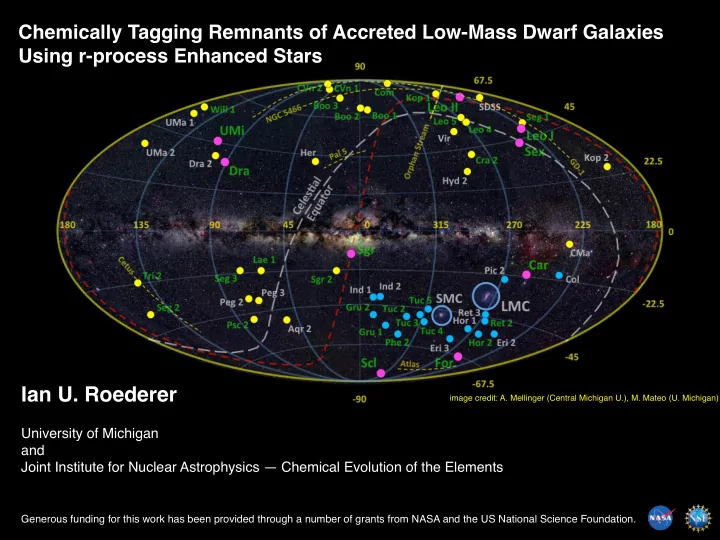

Chemically Tagging Remnants of Accreted Low-Mass Dwarf Galaxies Using r-process Enhanced Stars Ian U. Roederer image credit: A. Mellinger (Central Michigan U.), M. Mateo (U. Michigan) University of Michigan and Joint Institute for Nuclear Astrophysics — Chemical Evolution of the Elements Generous funding for this work has been provided through a number of grants from NASA and the US National Science Foundation.
The r-process is one of the fundamental ways that stars produce heavy elements. • r apid addition of neutrons • explosive site • high n density (~10 22-28 n cm − 3 ) • prolific (~10 − 2 M ⦿ per event) • rare (~10 − 3 − 4 per SN) Burbidge, Burbidge, Fowler, & Hoyle, Rev. Mod. Phys., 29, 547 (1957) Korobkin et al., Mon. Not. Roy. Astron. Soc., 426, 1940 (2012)
A small fraction of metal-poor stars are highly enhanced in r-process elements. r-process enhanced stars [Eu/Fe]* * metallicity [Fe/H] Sneden, Cowan, & Gallino, Ann. Rev. Astron. Astrophys., 46, 241 (2008) * [Eu/Fe] = log 10 ( N Eu ) STAR — log 10 ( N Eu ) SUN — [Fe/H] europium 63 (think of this as the level of r-process enhancement in a star) Eu 151.96
There are 83 r-process-enhanced stars ([Eu/Fe] > +0.7)* known in the Milky Way field. Stars with good distances from Gaia DR2. - calculate 6D positions and velocities - adopt a Milky Way potential [Eu/Fe] - compute orbits, angular momenta, specific energies, etc. * metallicity [Fe/H] Roederer, Hattori, & Valluri, Astron. J., 156, 179 (2018) * I think [Eu/Fe] > +0.7 is a more meaningful discriminant of “r-process enhanced” than [Eu/Fe] > +1.0.
Highly r-process-enhanced stars are not part of the Milky Way disk. V ⊥ = √ ( V R 2 + V z 2 ) V φ > 0 ⟶ prograde Roederer, Hattori, & Valluri, Astron. J., 156, 179 (2018)
Observations: each symbol/color Simulations: each cloud of represents r-process enhanced stars found points represents stars from one by three clustering methods applied to the disrupted satellite, 10 Gyr later energy ( E ) and integrals of motion ( J R , J φ , J z ) more bound less bound Roederer, Hattori, & Valluri, Astron. J., 156, 179 (2018) Gómez et al., Mon. Not. Roy. Astron. Soc., 408, 935 (2010)
All candidate groups show a small metallicity dispersion, even though chemistry played no role in the clustering analysis. 10 5 0 − 3.0 − 2.0 [Fe/H] Roederer, Hattori, & Valluri, Astron. J., 156, 179 (2018)
The groups of r-process Average [Fe/H] of stars in each galaxy Points represent individual dwarf galaxies in the Local Group. enhanced stars have low [Fe/H], suggesting they were born in low-mass dwarf galaxies. ULTRA-FAINT DWARF GALAXIES Total galaxy luminosity, M V fainter, less massive brighter, more massive Roederer, Hattori, & Valluri, Astron. J., 156, 179 (2018) Luminosity-metallicity relation for dwarf galaxies from, e.g., Kirby et al., Astrophys. J. Lett., 685, L43 (2008) Walker et al., Astrophys. J., 819, 53 (2016)
r-process enhanced stars like this… …came from UFD galaxies like this. Roederer, Hattori, & Valluri, Astron. J., 156, 179 (2018)
Simulations show that Percentage of MW halo stars that are highly r-process enhanced observed % of disrupted UFD galaxies highly r-process enhanced stars can account for most of in the MW halo the highly r-process enhanced stars in the Milky Way halo. fiducial model parameters varied Brauer et al., Astrophys. J., 871, 247 (2019)
The r-process enhanced stars have small orbital pericenters (< 8 kpc). 10 5 0 − 3.0 − 2.0 [Fe/H] Roederer, Hattori, & Valluri, Astron. J., 156, 179 (2018)
The surviving UFD galaxies all have large orbital pericenters (> 20 kpc). (elongated shape; tidally disrupting? nuclear star cluster?) Fritz et al., Astron. Astrophys., 619, A103 (2018)
HYPOTHESIS: the r-process enhanced UFD galaxies with small orbital pericenters became the r-process enhanced field stars of today. (elongated shape; tidally disrupting? nuclear star cluster?) Fritz et al., Astron. Astrophys., 619, A103 (2018)
The RPA is a multi-stage, multi-year effort to provide observational, theoretical, and laboratory constraints on the nature and origin of the astrophysical r-process. Tim Beers (Notre Dame) Maddie Cain (MIT) Julio Chaname (P. U. Católica) Ani Chiti (MIT) Rana Ezzeddine (MIT ➞ Florida) Anna Frebel (MIT) Maud Gull (MIT) Terese Hansen (Texas A&M) Erika Holmbeck (Notre Dame) Alex Ji (Carnegie Obs.) Jennifer Marshall (Texas A&M) Maria Paz Sepúlveda (P. U. Católica) Vini Placco (Notre Dame) Kaitlin Rasmussen (Notre Dame) Ian Roederer (Michigan) Charli Sakari (San Francisco St.) Rafael Santucci (U. F. de Goiás) Chris Sneden (Texas) Sandro Villanova (Concepción) Devin Whitten (Notre Dame) + others (the list is growing!) figure: IUR, unpublished
Recommend
More recommend